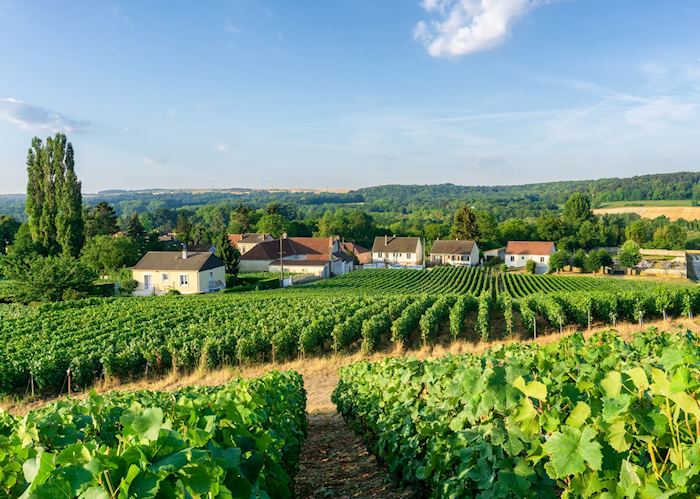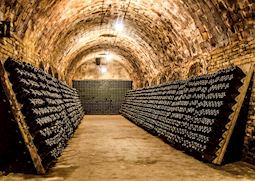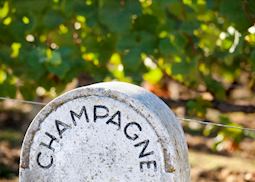Jump to:
The Gothic cathedral of Notre-Dame de Reims, tours and tastings at renowned Champagne houses and remnants of the Roman era in ‘the coronation city’, Reims
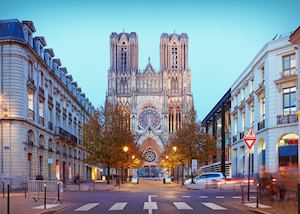 Known as la cité des sacres (‘the coronation city’) Reims has a long and significant history, with its huge cathedral hosting the coronation of France’s kings for centuries. You can visit the Gothic Notre-Dame de Reims to admire its rainbowed stained-glass windows and intricately carved portals.
Known as la cité des sacres (‘the coronation city’) Reims has a long and significant history, with its huge cathedral hosting the coronation of France’s kings for centuries. You can visit the Gothic Notre-Dame de Reims to admire its rainbowed stained-glass windows and intricately carved portals.
There’s also the UNESCO-designated Palais du Tau, a grand neoclassical palace-turned-museum where royals would stay before being crowned and hold lavish banquets afterwards. And, with Roman ruins, museums brimming with historic relics, Michelin-starred restaurants and many wineries producing the region’s renowned Champagne on its doorstep, there’s plenty more to see and do in Reims, too.
The unofficial capital of the Champagne region, Reims is a popular base for anyone with a taste for bubbly. You’ll find Champagne houses dotted across the city, many of which offer tours and tastings that give you a chance to learn more about the Champagne-making process and pick out the subtle differences between varieties. You could also head out of the city to explore the patchwork of vineyards that covers the region’s countryside on an e-bike tour with a local guide, pausing at family-run wineries for a sampling as you go.
Within the city itself, the Notre-Dame de Reims dominates. Built in the 13th century on a site occupied by churches since the 5th century, the cathedral has a dramatic Gothic style, with its most notable feature being its huge rose window on its western side. It was here, between 1223 and 1825, that 25 coronations of French kings took place, the most famous of which was Charles VII’s in 1429, attended by Joan of Arc.
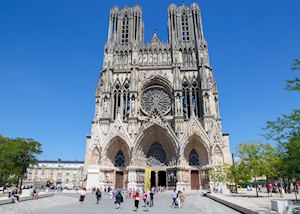 You can rent an audio guide to learn more the cathedral’s history and architecture as you wander around its striking interior. Among its treasures are a 15th-century astronomical clock, a Gothic organ case dating to the 15th and 18th centuries and a statue of Joan of Arc from 1901. You’ll also hear how the cathedral was almost destroyed during World War II, with much of its subsequent repairs paid for with donations from the wealthy American Rockefeller family.
You can rent an audio guide to learn more the cathedral’s history and architecture as you wander around its striking interior. Among its treasures are a 15th-century astronomical clock, a Gothic organ case dating to the 15th and 18th centuries and a statue of Joan of Arc from 1901. You’ll also hear how the cathedral was almost destroyed during World War II, with much of its subsequent repairs paid for with donations from the wealthy American Rockefeller family.
In fact, much of the city was badly damaged during both World Wars, and its restoration has resulted in attractive, wide pedestrian boulevards lined with trees and grassy quads. You’ll find Art Deco-style cafés and a thriving food-and-drink scene, including several Michelin-starred restaurants. You can also look out for surviving remnants of Reims’s ancient past, such as the Porte de Mars — a triumphal arch dating to the 3rd century, when Reims was a significant Roman town.
It’s worth visiting the Palais du Tau, a UNESCO-World Heritage Site. The palace was formerly an archbishop’s residence and where princes used to stay before and after their coronation, and you can only imagine the sumptuous banquets that took place here. The building was redesigned in a neoclassical style between the 17th and 18th centuries and visiting gives you a sense of its grand bygone days.
It’s now a museum displaying religious objects, statues and tapestries from the cathedral in its Gothic-style Salle de Tau (Great Hall), as well as outfits worn by kings for their coronation. Look out for Saint Rémi's 12th-century jewel-encrusted chalice and the talisman of Charlemagne, which dates to the 9th century.
Another UNESCO-World Heritage Site is the Basilique Saint-Rémi, a former Benedictine abbey church that blends mid-11th-century Romanesque influences found in its nave and transept with late-12th-century Gothic features. Next to it is the Musée Saint-Remi, housed in the former abbey, where you can see furniture, pottery, weapons and glasswork spanning the 6th to the 8th centuries, medieval sculptures and exhibits on Reims’s Gallo-Roman past, including arts and crafts, pottery and weapons from the Gallic people who once lived here.
Best time to visit Reims
With a mild climate, Reims can be visited at any time of year. Harvest season falls between late September and early November, and while it’s a good time to visit to make the most of the festivities, it can be hard to get tastings at Champagne houses as they become busy.
who's been there
-
617-223-4521617-223-4762
- Make an inquiry
Places near Reims
- Paris 82 miles away
- Arras 92 miles away
- Lille 105 miles away
- Rouen 134 miles away
- Burgundy 142 miles away
- Château de Chambord 162 miles away
- Château de Cheverny 170 miles away
- Honfleur 172 miles away
- Colmar 173 miles away
- Strasbourg 175 miles away
- Normandy 177 miles away
- Château de Chaumont-sur-Loire 180 miles away
- The Loire Valley 182 miles away
- Alsace 185 miles away
- Amboise 189 miles away
- Château de Chenonceau 191 miles away
- Château de Villandry 210 miles away
- Bayeux 214 miles away
- Château d'Azay-le-Rideau 215 miles away
- Chinon 227 miles away
- Lyon 245 miles away
- Annecy 251 miles away
- Mont Saint-Michel 257 miles away
- Talloires 257 miles away
- Chamonix 271 miles away
- Rhône-Alpes 290 miles away
Photos of Reims
Accommodation choices for Reims
We've selected a range of accommodation options for when you visit Reims. Our choices usually come recommended for their character, facilities and service or location. Our specialists always aim to suggest properties that match your preferences.
-
![Grand Hôtel Continental, Reims]()
Grand Hôtel Continental
Reims -
![Domaine Les Crayères]()
Domaine Les Crayères
Reims
Ideas for experiencing Reims
Our specialists seek out authentic ways to get to know the places that could feature in your trip. These activities reflect some of the experiences they've most enjoyed while visiting Reims, and which use the best local guides.
-
Champagne by e-bike ![Champagne cellars]()
Champagne by e-bike
Champagne by e-bike
Spend the day exploring the history and vine-covered landscapes of France’s Champagne region by e-bike with a guide. You’ll stop at the village of Hautvillers, known as the birthplace of Champagne, visit two Champagne houses for tastings and enjoy a Champagne lunch in Épernay.
View details -
Champagne discovery ![Champagne grapes on the vine]()
Champagne discovery
Champagne discovery
Explore France’s Champagne region with a private driver-guide. You’ll visit two wineries for tours and tastings, including a larger, well-known winery and a family-run boutique option. You’ll also visit historic Hautvillers, birthplace of Champagne, and pause for lunch paired with bubbly at a Champagne house.
View details



